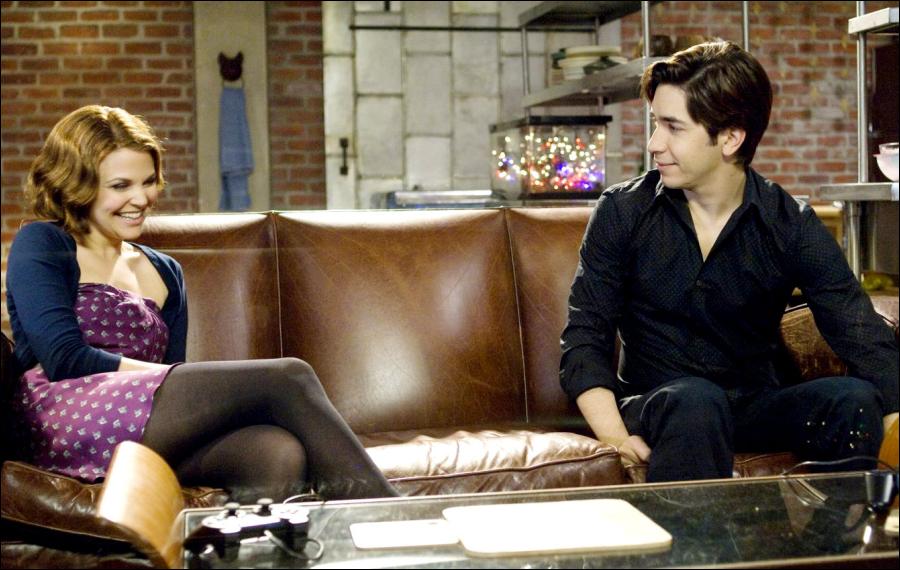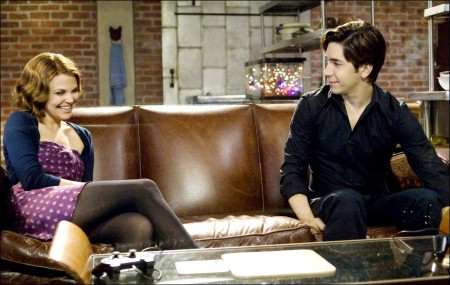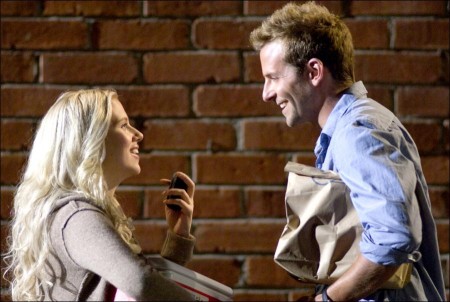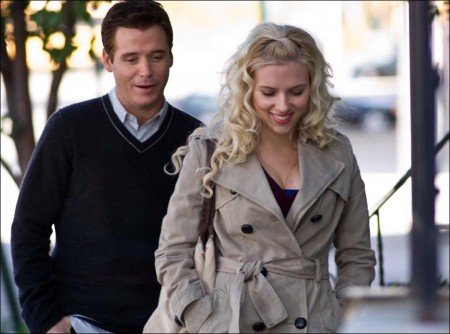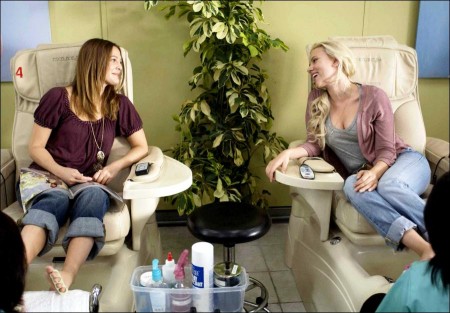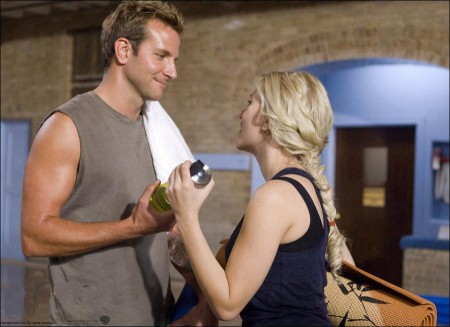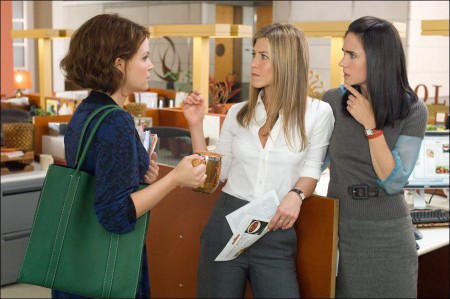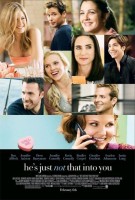About the Producton
GIGI
Maybe he called me and I didn’t get the message. Or maybe he lost my number, or was out of town, or was hit by a cab, or his grandma died.
ALEX
Or maybe he just didn’t call because he has no interest in seeing you again.
If you’ve ever sat by the phone wondering why he said he would call, but didn’t, or if you can’t figure out why she doesn’t want to sleep with you anymore, or why your relationship just isn’t going to the next level… he (or she) is just not that into you. “This might be the first feature film inspired by one line of dialogue from one episode of a television show,” remarks director Ken Kwapis.
In actuality, the phrase first inspired “Sex and the City” scribes Greg Behrendt and Liz Tuccillo to write what became the bestselling book He’s Just Not That Into You. “I didn’t come into this world hoping to write a relationship book,” explains Behrendt, who not only turned the phrase into a bestseller, but also hosted a no-nonsense talk show for the romantically challenged. “It all stemmed from an offhanded comment I made to somebody over lunch. Telling a woman that a guy who doesn’t call her doesn’t like her just seems like common sense.”
“I really loved that episode of `Sex and the City,’” says producer Nancy Juvonen. “Then I found my way to the book and I completely related to the idea of being practical about dating and relationships, and to all the myths that we sort of create for ourselves or for each other-all these things we make up because we’re not getting the phone call or the invitation that we really want.” Her thoughts immediately turned to film. “I had all of these ideas on how to turn this notion of `He’s just not that into you’ into an ensemble feature, without ever actually saying that line, and I knew I had to make this movie.”
At the time, she never imagined that the resulting ensemble would be a dream cast, including Ben Affleck, Jennifer Aniston, Drew Barrymore, Jennifer Connelly, Kevin Connolly, Bradley Cooper, Ginnifer Goodwin, Scarlett Johansson, Kris Kristofferson and Justin Long. But first, they needed a script. Juvonen describes the source material as anecdotal. “A lot of the book was, `I hear what you’re saying, Greg, however, I really think this guy did lose my number, because he really liked me when we met at the bar.’ And Greg’s response would be something along the lines of `Honey, he doesn’t like you, go for someone who does.’ But there wasn’t a real story to follow.” She remedied that by reaching out to the writing team of Abby Kohn and Marc Silverstein, with whom she had worked years before on the hit comedy “Never Been Kissed.”
“It was time to sort of get that band back together. We’d all grown for a good ten years, so I think we were all more dynamic and a little more clever and had a little more relationship experience to really pour into these stories. We started taking our own stories, and those from friends, and enhancing them. I think they’re just the best writers in town and it was really fun.”
Kohn continues. “We looked at the chapter headings: He’s just not that into you if he’s not calling you, … if he’s sleeping with someone else, … if he’s not marrying you, and so on. And that was really the biggest inspiration we took from the book, since the book had no actual characters or plot. We thought those chapter titles could each be an inspiration for an individual story. And that’s what grew into our ensemble movie.”
Kohn and Silverstein let the title be their guide throughout the writing process. “If a guy’s acting like he’s not into you, he’s not,” states Silverstein. “It’s a simple crystallization of something that’s very obvious. Greg’s advice in the book is always that it doesn’t matter why; it just is.”
Kohn adds, “We tend to over-analyze everything that happens in a relationship. And so even though the conversation that you had with that guy was maybe 45 seconds, the analysis afterwards can be four or five hours. So we felt that, for instance, with Gigi, Janine and Beth-the notion of these women being in an office together and they’re supposed to be working, but really what they’re doing is dissecting a phone message or deciding how to play the next phone message or whatever. That seems pretty real.” To direct, Juvonen called upon ensemble pro Ken Kwapis, who is accustomed to working with female-driven stories and interwoven relationships in such films as “The Sisterhood of the Traveling Pants,” and who is highly-regarded for TV’s “The Office.” Once he saw the material he didn’t hesitate.
“The reason the book was so popular of course is that it’s 100 percent relatable,” offers Kwapis. “So was the script. I just read it and went crazy for it. I was immediately struck by the fact that of these nine characters, I related to every one of them-all five women and all four men equally. And while it was very funny, everything that was comical in this story came out of behavior that was true, that was real, that was often embarrassing… things that I had done myself and that I thought would make the audience would say, `Oh, that’s me!’
“I did a lot of research to prepare for this film, long before I ever knew I’d be directing it,” Kwapis deadpans. “I went out on my first date when I was 16 and I got married when I was about 30. In-between the first date and getting married-even after getting married-I just made every possible mistake that a person could in trying to meet and fall in love.”
“The first thing Ken said was, `I’m not one of these characters, I’m all of them. I feel for all of them,’” recalls Juvonen of her initial conversation with the director. “We talked for two and a half hours and it was such a stimulating, perfect, fabulous conversation. It was like talking to an old friend.”
“When I met Nancy, we hit it off perfectly,” Kwapis agrees. “We both realized we wanted to make a film in which there were no good guys or bad guys, just people who make choices. We both felt this film should inspire conversation about the choices that the characters make, that the audience may disagree with the choice that someone makes but understands fully why he or she made it. Our mission was to present the characters in a way that confounded the viewer’s ability to judge them.”
“The film is about people misreading the signals between one another,” says Kwapis. “There are just as many men who pine after and are rebuffed by women as there are women who are being rebuffed by men. The men and women are equally confused in this film, the men make as many of the mistakes as women do; it’s wonderfully evenhanded that way.”
MARY
Things have changed. People don’t just meet organically anymore. If I want to make myself more attractive to the opposite sex, I don’t go get a new haircut – I update my profile. That’s just how it is.
One of the biggest challenges for the writers was to create characters to illustrate the various chapters of the book, and somehow weave those stories together.
“Character A is going out with character B, character B is really into character A, but character A is really into character C. Character C is dating character D. Character D is married to character E. Character E works with character F. And so on. That’s what the story is about,” director Ken Kwapis illustrates.
“We made a diagram,” says Marc Silverstein, “beginning with Gigi and Conor.”
“It all starts with their first date,” adds Abby Kohn.
Then one couple became nine interwoven stories. Keeping so many characters’ relationships straight might have seemed a daunting task; the job of casting the right actor for each role could have been equally overwhelming.
“In any kind of normal romantic comedy situation, your chief job is to cast two people who have chemistry together,” explains Kwapis. “In this case we had to cast several different people who had to have several different good chemistries with one another. It’s a wonderful test of orchestration. It’s, in effect, a kind of theme in variations. You want a lot of variety and, at the same time, there needs to be some consistency between all the players and all the stories.”
Producer Nancy Juvonen was thrilled with the cast. “When we started getting these really amazing actors and actresses involved in the stories, we realized that there was something that each one of them related to about the story that they were telling, in some way or another. They each embraced their character in a really natural way.”
If he’s not calling you…
Ginnifer Goodwin was cast as Gigi, the character who is really the catalyst for the overall story. “I loved the concept,” asserts Goodwin. “It felt like something that, when incorporated into your life, could lead to more fulfilling relationships and real self-confidence, because you know you’re dealing with the honest feelings between two people.”
Producer Juvonen knew the part of Gigi was a particularly critical one. “Gigi’s the emotional heart, and she also represents the person we all once were, if we aren’t right now,” Juvonen explains. “Some of us hit it better, some of us were cooler than that, and some of us were probably worse than that. But she wants a mate. It’s worth it to her to call, and call again if they don’t call, and do a drive by, and hope that she might accidentally run into someone. She might make some people a little uncomfortable, but she is so honest and earnest in this pursuit, that you can’t judge her. And Ginnifer was perfect for the role. She’s very smart but also has a wonderfully naïve, good-girl quality. She just puts it out there and, in the same way she embraces life, she embraced Gigi.”
Goodwin says she connected to the honesty of the role. “I fell madly in love with Gigi and found her completely endearing,” the actress beams. “Gigi is quite eager to find her soul mate and get married and live happily ever after, but she has been grossly uneducated in the realities of relationships, she’s been taught all the wrong signs and overanalyzes and obsesses about it. She will commit to something and ride that train as far as it will go, right or wrong. She’s very resilient.”
“There are a lot of awkward moments in the film,” Kwapis states, “and Gigi probably has the lion’s share of those embarrassing moments. But she’s always going to open herself up too much and be too vulnerable. She’d rather be that and fail in a sort of fools-rush-in way than never connect with anyone.”
Also joining the cast was actor Kevin Connolly as Conor who, along with Gigi, starts the ball rolling with that first date. “He’s a young, up-and-coming real estate agent. He’s got a pretty decent business but he’s still looking for his niche,” states the actor. Unbeknownst to Gigi, Conor has someone else on his mind. “Conor’s head-over-heels crazy about Anna. She keeps him on the hook, throws him just enough of a line out there to keep him holding on. He’s got tunnel vision, he’s a little obsessed,” laughs Connolly.
If she’s not sleeping with you… Unfortunately for Conor, Anna has other plans.
Cast in the role of Anna, Scarlett Johansson offers, “She’s a yoga instructor, an artist, a singer, kind of a free spirit, walking through life with her feelers out. She has a sort of `boyfriendship’ with Conor-she enjoys his company but she’s not interested in a commitment with him. She likes having him around, having him flatter her, so she gives him some mixed signals, which frustrates him a lot.”
Anna frequently turns to her friend Mary for advice, though it’s not always the best. Drew Barrymore, who also serves as one of the film’s executive producers, took on the role of the ad sales rep at a local newspaper. “I related to Mary and her trials and tribulations of trying to find the right guy,” says Barrymore. “And I loved the fact that her friends are all trying to figure it out with her in this modern, sometimes unromantic, confusing, technological approach to romance. Not long ago, we were waiting months at a time for just a letter and now we live in an age where everything is instant gratification.”
Says Kwapis, “Mary, Drew Barrymore’s character, is really eager to find a boyfriend, but seems to be a victim of technology. She’s a victim of text mail, she’s a victim of the internet, she’s a victim of voice mail. She’s a victim of everything, as she puts it. She’s being rejected by every technological portal available.”
“Drew really responded to Mary,” recalls Juvonen. “I think Drew herself is sort of befuddled by technology. And she’s certainly a romantic at heart. Mary is in pursuit of a relationship-she’s on MySpace and Facebook-and that’s sort of how she ends up having these potential relationships that don’t go anywhere. The character was really a way to represent technology and dating now, with all these methods that seem mathematical and electronic, instead of just meeting people face-to-face. I think the phone is hard enough, when you aren’t touching each other or looking at each other. But now, to be reading what someone says, pouring over two lines of a text message, asking your friends, `What do you think he meant, and does that mean I should call him?’ It wasn’t like that ten years ago. The ease with which we can just send off a sexy little message to someone is a little scary. And sometimes fun. This is a new age. We’re breaking new ground.”
If he’s not marrying you…
If Mary and Anna represent those still looking for love, Beth and Neil stand for those who have found it… but aren’t sure if it’s enough. Ben Affleck plays Neil, a photographer who has been involved with Jennifer Aniston’s character, Beth, for several years.
“Neil is a really interesting character,” says Juvonen, “because you assume one thing about him, and it turns out to be something completely different. Neil doesn’t believe in marriage. He’s a photographer; he’s been with his girlfriend for over seven years and he really digs her, but he thinks things change once marriage occurs. Ben is so charming and funny and easygoing; he’s sort of all guy. And that’s what we wanted Neil to be, as well as artsy and a thinker-a very smart, smart fellow.”
“Beth and Neil have been together for seven years,” says Aniston of the couple, “and he is very content not being married and doesn’t believe in it or understand why it has to happen. But she wants to be married and starts to sort of feel like, `Wow, am I being duped?’”
“Beth has been dealing with this conceit for a long time and swallowing it because she’s in a fabulous relationship,” Juvonen details. “But she wants more, and it turns out her littlest sister is tying the knot, and she’s doing it very quickly, and it sort of pushes Beth over the edge.”
If he’s sleeping with someone else…
In their professional lives, Beth and Gigi work in marketing at a spice company with Janine, who is married to Ben, remodeling her home and angling to start a family. “Janine is remodeling their house,” Kwapis points out, “but I think on some level what she really wants to do is remodel their relationship.”
“Janine is a bit old fashioned in some ways,” says actress Jennifer Connelly, who portrays her. “She hates lying, so for her, it’s really important to be with someone straightforward and honest, to trust the person she’s with. She likes the idea of marriage. She and Ben knew each other for a long time, they were best friends and they got married. After a while, so much of it becomes habit, all that stuff that you’re used to for so long. Now they’re in a rut.”
Her husband, Ben, is played by Bradley Cooper. “When Bradley Cooper came in, we were done,” remarks Juvonen. “We just thought, `This is Ben, in the best way.’ Bradley was so sincere that there wasn’t anything slimy about the character. He sort of wears his heart on his sleeve.”
“I really wanted to play Ben because he’s so conflicted, so paralyzed by his fears,” Cooper explains. “He’s a lawyer and he’s married to Janine, his college sweetheart. He’s sort of going about his life, going through the motions a little, not really able to take a stand in his marriage. Then he meets this girl and he just can’t get her out of his system. I liked that it’s an honest portrayal of romantic relationships, what people really want and what they do, without trying to sugarcoat it.”
…then he’s just not that into you.
When it comes to women, Alex, played by Justin Long, doesn’t sugarcoat a thing. “Alex is, in effect, the voice of the book,” states director Kwapis.
“My character is sort of an advice-giver,” adds Long. “He’s the kind of guy that is pretty honest, very assertive, speaks his mind. He gets it; he understands women because he’s been through his share of them,” the actor grins, “but he’s never given himself over to anybody emotionally. So when he meets Gigi and she’s in need of his advice-or so he thinks-they embark on a sort of `My Fair Lady’-like relationship, where Alex is Henry Higgins to Gigi’s Eliza Doolittle. He tries to make her understand that guys just aren’t that complicated, that if a guy doesn’t call it doesn’t mean that he dislikes her or doesn’t find her attractive. He’s just not that into her. He’s probably calling someone else.”
“Alex is the guy who dispenses the hard truth to female friends,” the director comments. “He’s a restaurant manager, so he’s constantly observing couples in action- people doing the mating dance, meeting, greeting, trying to connect-and he’s figured it out. When he meets Gigi, he decides to take her on in this sort of Pygmalion-like fashion; his job is to get this one core truth into her head, and that is `Don’t misread the signals.’”
Juvonen explains further. “Alex wants to observe. He wants to be the guy that has these great quips about relationships, but never really jumps in the pool himself. He sort of skims his toe along the pool and judges everyone else who is actively swimming about and looking like idiots.”
One character-perhaps the only one in the film-to truly have it all figured out is Beth’s father, Ken, played by veteran actor and musician Kris Kristofferson.
“He’s a fun character because he says what he feels. He’s retired, he’ll say whatever he wants, and I can identify with that,” smiles Kristofferson, who thoroughly enjoyed being part of the ensemble. “It’s a great script and a great cast. The nice thing was finding out what a great crew it is. I couldn’t have asked for a nicer bunch of people.”
Kwapis felt the overall collaboration was right on point. “With all of these different characters, I would hope that an audience could have the pleasure of seeing themselves reflected in several ways, and I think this cast really accomplishes that.” “Everyone did a really good job of not hitting it over the head, while definitely extolling the virtues of what we said in the book,” declares author Greg Behrendt.
BETH
You never feel like we’re going against nature by not getting married?
NEIL
Going against nature is like that cat who started nursing that monkey. We’re just two people who aren’t married.
With all of the interconnecting relationships, the filmmakers found themselves dealing with a somewhat nontraditional romantic comedy.
“An important distinction between `He’s Just Not That Into You’ and most romantic comedies is that in most romantic comedies, there’s a man and a woman and the question is not whether they’ll get together, but how,” offers Kwapis. “In our film, there are nine characters and the question is, `Will any of them get together?’”
To answer this it’s key to understand one of the finer points of the central theme of both the book and the film: the “no exceptions” rule. “If a guy doesn’t call you and doesn’t call you and then still doesn’t call you, the rule is he doesn’t want to call you,” explains Kwapis.
“The exception is that he’s not calling you because he’s suddenly got a whopping flu and he’s laid up and can’t even reach to get his cell phone. Those are the rare exceptions. The rule is if a guy acts like he doesn’t care, it’s because he actually doesn’t care. Gigi really clings to the idea that she could be the exception.”
Juvonen continues, “One of the biggest points we wanted to convey is that every woman, by good rights, believes that she is the exception to the rule. She thinks, `I’m a little bit different.’ Of course, in most cases, she’s not.”
The producer smiles. “We are each the exception to someone, but just not to everyone. As Gigi’s looking for romance, she sort of narrows down this field hoping to find the right guy and therefore become the exception. Basically, you will be the exception, eventually, if you find the right person-the person you’re the exception for and he or she is for you. But only if you first consider yourself the rule.”
But it’s not easy. “One of the toughest things to figure out when you’re interested in someone is how interested they are in you, and then try to decide whether they are sufficiently attracted to you that you can actually make a move,” declares Kwapis. “A lot of the characters’ actions inspired debate among the crew, even as we were shooting it. I’ve never heard crew guys talk about relationships the way they talked about the relationships between characters on this film. Men usually don’t, but the guys on this crew did.”
The director clearly enjoyed the dialogue. “We all know movies where the characters are very clearly black and white and we love them. We love to hate a villain and we love to root for a good guy. This is not that film. This is a film that plunges you into a lot of emotional gray areas.”
JANINE
“Okay, so clearly he hasn’t called. Maybe he’s away on business.”
GIGI
“He sells real estate. In Baltimore. Staying in town is his business.”
For the setting of “He’s Just Not That Into You,” the filmmakers considered New York and Los Angeles, but wanted a smaller, more intimate city feel. They turned to Baltimore.
“Baltimore is this wonderful city, it has such a great sense of itself and it generates its own culture,” admires Kwapis. “It’s very much its own town but at the same time it also has a familiar, industrial feeling. I loved the architecture, all the brick.”
“Ken had worked in Baltimore before and liked the texture and color of it,” says production designer Gae Buckley. “We also wanted to set the story in early fall and use an autumnal color palette; Baltimore seemed like the right choice.”
Not everything could be shot on location, however, so Buckley’s challenge was to turn parts of Los Angeles into the eastern town, which features buildings that date back to the 1700s.
“There are a lot of people in this movie; they all live somewhere, they all work somewhere, they all date somewhere,” she expounds. “We found locations and determined what we could do to them to make them look more like Baltimore, which is primarily a brick city. And you want to avoid seeing palm trees.”
One of the designer’s favorite locations became the Baltimore Blade newspaper office. “It’s just a lovely little space, with layers of windows and beautiful sand-blasted brick. Mary is sort of an interesting, quirky character so it was fun to put her in that place.”
Other sets were also designed to mirror the personalities of the characters inhabiting them. “Beth and Neil live in a loft; he’s established as an artist, and we used an actual photographer’s studio for their place,” Buckley says. “But it had another studio behind it, so we built a window and shot a panorama of Baltimore, with the Domino Sugar sign, and put that outside.” Buckley says the billboard was a very deliberate choice.
“I was scouting with Debbie Dorsey of the Baltimore Film Commission, and she pointed out that you can see the Domino Sugar sign from everywhere in the city, so I thought, `That has to be in the movie.’”
That wasn’t the city’s only iconic image to make it into the film. “There’s Natty Boh, the National Bohemian Brewery’s logo, a cartoon guy with a big black mustache; his face is all over town and we incorporated it into the story as well. And the Washington Monument in Mount Vernon, of course.”
“It’s a lovely city,” Juvonen remarks. “There are fabulous restaurants, the harbor. There is plenty to do and yet it’s still small; you feel like people are really living in Baltimore and can own houses or have apartments without breaking the bank or having to be wildly successful. There are great row houses that are now being renovated, and it’s really an American city. It just sort of seemed like the right city to represent our realistic stories.”
Girls are taught a lot of stuff growing up. If a guy punches you, he likes you. Never try to trim your own bangs. And someday you will meet a wonderful guy and get your very own happy ending.
“There are no easy, obvious answers when it comes to men and women,” says director Kwapis. “What I’m really hoping is that people come away from the film with questions about the choices that the characters made. I’d love nothing more than to feel that people went out and got a coffee and disagreed about why a certain character did something.”
Producer Juvonen agrees. “There’s that notion that we all have, `I need to have someone now, so I’m going to take my square peg and shove it into the round hole and hope that it feels right.’ But it doesn’t feel right. In the movie, we wanted to represent all of that for women and men, because when you really want something, you’re willing to put yourself in a pretzel shape to make it be what you are pretending that it is. But when you finally let it go, everything starts flowing, your whole body just relaxes itself from being in something that wasn’t natural, that wasn’t working for you. And it feels better.”
Kwapis continues, “There is messiness to life. People make choices and then regret the choices they’ve made. We tried to show all of that. Hopefully, there will be as many opinions as there are people in the theatre.”
“Of course, we wanted to make sure there was always hope, because that’s Liz and Greg’s real message,” says Juvonen. “Sometimes it is better to just move on and get out of a relationship-that’s really what the book is saying. The line `He’s just not that into you’ is supposed to be helpful for people. You don’t want to be with someone who’s not really, really into you and doesn’t think you’re fabulous. And someone out there will.”
Production notes provided by New Line Cinema.
He’s Just Not That Into You
Starring: Ben Affleck, Jennifer Aniston, Drew Barrymore, Scarlett Johansson, Justin Long, Jennifer Connelly, Ginnifer Goodwin
Directed by: Ken Kwapis
Screenplay by: Abby Kohn, Marc Silverstein
Release Date: February 6, 2009
MPAA Rating: PG-13 for sexual content and brief strong language.
Studio: New Line Cinema
Box Office Totals
Domestic: $93,937,453 (56.9%)
Foreign: $71,088,153 (43.1%)
Total: $165,025,606 (Worldwide)
